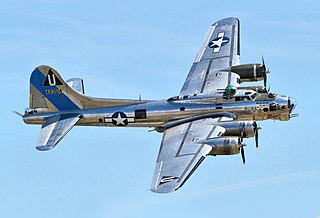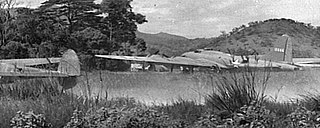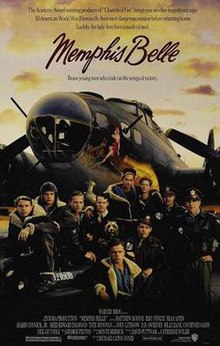
The Boeing B-17 Flying Fortress is an American four-engined heavy bomber aircraft developed in the 1930s for the United States Army Air Corps (USAAC). A fast and high-flying bomber of its era, the B-17 was used primarily in the European Theater of Operations and dropped more bombs than any other aircraft during World War II. It is the third-most produced bomber of all time, behind the American four-engined Consolidated B-24 Liberator and the German multirole, twin-engined Junkers Ju 88. It was also employed as a transport, antisubmarine aircraft, drone controller, and search-and-rescue aircraft.

Royal Air Force Polebrook or more simply RAF Polebrook is a former Royal Air Force station located 3.5 miles (5.6 km) east-south-east of Oundle, at Polebrook, Northamptonshire, England. The airfield was built on Rothschild estate land starting in August 1940.

The Memphis Belle: A Story of a Flying Fortress is a 1944 documentary film which provides an account of the final mission of the crew of the Memphis Belle, a Boeing B-17 Flying Fortress. In May 1943 it became the third U.S. Army Air Forces heavy bomber to complete 25 missions over Europe, but the first to return to the United States.

The Memphis Belle is a Boeing B-17F Flying Fortress used during the Second World War that inspired the making of two motion pictures: a 1944 documentary film, Memphis Belle: A Story of a Flying Fortress and the 1990 Hollywood feature film, Memphis Belle. It was one of the first United States Army Air Forces (USAAF) B-17 heavy bombers to complete 25 combat missions, after which the aircrew returned with the bomber to the United States to sell war bonds.

The 91st Bomb Group (Heavy) was an air combat unit of the United States Army Air Forces during the Second World War. Classified as a heavy bombardment group, the 91st operated B-17 Flying Fortress aircraft and was known unofficially as "The Ragged Irregulars" or as "Wray's Ragged Irregulars", after the commander who took the group to England. During its service in World War II the unit consisted of the 322nd, 323rd, 324th, and 401st Bomb Squadrons. The 91st Bomb Group is most noted as the unit in which the bomber Memphis Belle flew, and for having suffered the greatest number of losses of any heavy bomb group in World War II.

Air Force is a 1943 American World War II aviation film directed by Howard Hawks and starring John Garfield, John Ridgely, Gig Young, Arthur Kennedy, and Harry Carey. The film was distributed by Warner Bros. and produced by Hal B. Wallis and Jack L. Warner. Conceived by then - Lieutenant General “Hap” Arnold in the aftermath of the Pearl Harbor attack, it was originally scheduled for release on December 7, 1942, on the first anniversary. It became impossible to meet that deadline, and it premiered in New York City on February 3, 1943 and was released on March 20. The film's storyline revolves around an actual event that occurred on December 7, 1941. An aircrew ferries an unarmed 1940 series Boeing B-17D Flying Fortress heavy bomber, named the Mary-Ann, across the Pacific to the United States Army Air Forces base at Hickam Field. They fly right into the middle of the Japanese air attack on Pearl Harbor and the beginning of America's major involvement in the Second World War. An uncredited William Faulkner wrote the emotional deathbed scene for Ridgely, who played the commander and pilot of the Mary-Ann.

The Wild Blue: The Men and Boys who Flew the B-24s over Germany, by historian and best selling author Stephen Ambrose, was a New York Times best selling non-fiction book published in 2001. It details the lives and World War II experiences of pilots, bombardiers, navigators, radio operators and gunners flying B-24 bombers of the U.S. Army Air Force against Nazi Germany. The book entails a recounting of George McGovern's exceptional career as a chief pilot of a B-24 with the 455th Bomb Group in Italy, encompassing 35 bombing missions. With the odds of surviving all 35 missions as low as 50 %, the bomber crews flew during dangerous daylight hours, in risky tight flying formations, and despite bad weather and assaults of heavy, deadly, flak from ground-based German anti-aircraft guns.

Target for Tonight is a 1941 British World War II documentary film billed as filmed and acted by the Royal Air Force, all during wartime operations. It was directed by Harry Watt for the Crown Film Unit. The film is about the crew of a Wellington bomber taking part in a bombing mission over Nazi Germany. The film won an honorary Academy Award in 1942 as Best Documentary by the National Board of Review. Despite purporting to be a documentary there are multiple indicators that it is not quite as such: film shots include studio shots taken from the exterior of the aircraft looking into the cockpit whilst "in flight"; several stilted sections of dialogue are clearly scripted; on the ground shots of bombing are done using model trains; and several actors appear. The film does give a unique insight into the confined nature of the Wellington's interior and some of the nuances of day to day operation such as ground crew holding a blanket over the engine while it starts to regulate oxygen intake.

Shoo Shoo Shoo Baby, originally Shoo Shoo Baby, is a Boeing B-17 Flying Fortress in World War II, preserved and currently in storage at the National Museum of the United States Air Force, awaiting transfer to the Smithsonian's National Air and Space Museum. A B-17G-35-BO, serial number 42-32076, and manufactured by Boeing, it was named by her crew for a song of the same name made popular by The Andrews Sisters, the favorite song of its crew chief T/Sgt. Hank Cordes. Photographs of the bomber indicate that a third "Shoo" was added to the name at some point in May 1944 when the original aircraft commander completed his tour of duty and was replaced by another pilot.

Combat America is a 1945 documentary film produced in World War II, narrated by Clark Gable. At the time of the film's production in 1943, Gable was a 1st Lieutenant in the Eighth Air Force, part of the United States Army Air Forces. While he was stationed in England, Gable flew five combat missions from May 4–September 23, 1943, and during one of them, his boot was struck by an anti-aircraft shell, and he was nearly hit by other flak bursts. Gable's film crew included MGM cameraman Andrew J.McIntyre; 1st Lt. Howard Voss, a sound engineer; Master Sgt. Robert Boles, a cameraman; Master Sgt. Marlin Toti, another cameraman; and 1st Lt. John Mahlin, a scriptwriter."

Old 666 was a Boeing B-17E Flying Fortress heavy bomber, serial number 41-2666, assigned to the United States Army Air Forces (USAAF) 19th and 43rd Bombardment Groups in 1942–1943. It is notable for being the aircraft piloted by Lt. Col. Jay Zeamer Jr. on the 16 June 1943 mission which earned him and 2nd Lt. Joseph Sarnoski each a Medal of Honor, and all other members of the aircrew the Distinguished Service Cross.

The Charlie Brown and Franz Stigler incident occurred on 20 December 1943, when, after a successful bomb run on Bremen, 2nd Lt. Charles "Charlie" Brown's B-17F Flying Fortress Ye Olde Pub of the United States Army Air Forces (USAAF) was severely damaged by German fighters. Luftwaffe pilot Franz Stigler had the opportunity to shoot down the crippled bomber but did not do so, and instead escorted it over and past German-occupied territory so as to protect it. After an extensive search by Brown, the two pilots met each other 50 years later and developed a friendship that lasted until Stigler's death in March 2008. Brown died only a few months later, in November of the same year.
This is a partial list of accidents and incidents involving the Boeing-designed B-17 Flying Fortress. Combat losses are not included except for a very few cases denoted by singular circumstances. A few documented drone attrition cases are also included.

Fortress is a 2012 war film directed by Michael R. Phillips and stars Bug Hall, Donnie Jeffcoat, Sean McGowan and Joseph Williamson. The film was released by Bayou Pictures and although initially intended for wider release, was a direct-to-video release on July 31, 2012 made by Monarch Video. Fortress takes its name from the iconic Boeing B-17 Flying Fortress World War II bomber that was the centerpiece of the aerial battle in Europe.

Dauntless Dotty is the nickname of a Boeing B-29-40-BW Superfortress during the Second World War that led the first B-29 raid on Tokyo on 24 November 1944, the first bombing attack of the Japanese capital since the Doolittle Raid on 18 April 1942.

Hot Stuff is the nickname of a Consolidated B-24 Liberator, 41-23728, of the 8th Air Force that was used in World War II. It was the first heavy bomber in the 8th Air Force to complete twenty-five missions in Europe in World War II.
The Mi Amigo memorial is a war memorial at Endcliffe Park, Sheffield, England, marking the World War II crash site of the USAAF B-17 Flying Fortress Mi Amigo.

Everett Ernest Blakely was a career officer of the United States Air Force. He was a highly decorated B-17 pilot with the “Bloody Hundredth” Bombardment Group of the 8th Air Force in Europe during World War II. He received eleven medals for his service including the Silver Star for “gallantry in action”, the Distinguished Flying Cross for “heroism or extraordinary achievement during aerial flight” and the Air Medal with 4 oak leaf clusters. Blakely and the crew of his plane “Just A Snappin” long held the record for the most enemy aircraft shot down on a single mission. The crew of Just A Snappin was credited with 9 enemy aircraft shot down. He also received his Pilot Wings with 3 stars from the Colombian Air Force.

















